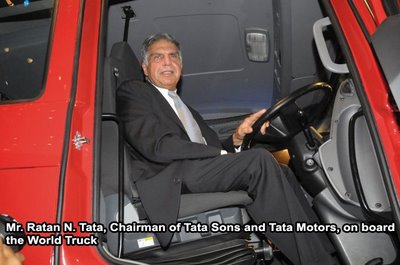 Mr. Ratan Tata said: “The developing infrastructure in India makes it possible for transporters to reap the benefit of trucks with higher power, speed and carrying capacity. The new range from Tata Motors will meet those needs. It will also help us penetrate international markets more effectively and competitively.”
Mr. Ratan Tata said: “The developing infrastructure in India makes it possible for transporters to reap the benefit of trucks with higher power, speed and carrying capacity. The new range from Tata Motors will meet those needs. It will also help us penetrate international markets more effectively and competitively.”
The new plant set up in Jamshedpur for the World Truck can produce 55,000 units initially and can be expanded to 1.5 lakh units based on the market demand. The company expects international volumes to be at par with numbers in India. The range comprises multi-axle trucks, tractor-trailers, tippers, mixers, and special application vehicles. Besides India, they will also gradually be introduced in South Korea, South Africa, the SAARC countries and the Middle East.
The Managing Director of Tata Motors, Mr. Ravi Kant said: “The range is an output of collaboration across the Tata Motors family, supplemented by inputs from partners across the world. This approach has enabled us to harness appropriate expertise and develop relevant products faster than ever before.”
 For the next couple of months, Tata Motors will seed the market with a few of these trucks by giving it to some key customers. “The trucks will be available in the domestic market in the second quarter of this fiscal,” said Tata Motors Executive Director-Commercial Vehicles, Mr. P. M. Telang.
For the next couple of months, Tata Motors will seed the market with a few of these trucks by giving it to some key customers. “The trucks will be available in the domestic market in the second quarter of this fiscal,” said Tata Motors Executive Director-Commercial Vehicles, Mr. P. M. Telang.
The company, however, would start exporting these trucks only by the end of the current financial year. “We expect to start export from the end of this fiscal. Initially, we will be exporting to countries such as South Africa, the Middle East, Russia and Turkey,” he added.
But why a world truck? ask Mr. R. Ramakrishnan (Ramki, as he is known to many in the industry), Head of Sales and Marketing – Medium and Heavy Commercial Vehicles, Tata Motors, and he says, the whole idea of making a World Truck started a decade ago, in 2000, when Tata Motors announced the worst results in its corporate history, a loss of Rs. 560 crores. “This is when we started looking inwards introspecting and understanding as to where we went wrong. What should we do to ensure that this performance doesn’t repeat ever in the history of Tata Motors. While we took some immediate steps to improve quality, reduce cost and focus more on our customers, a group of us started looking at what we should do in the long term”.
He said: “Looking at our product strategy, the market growth and the products we were offering then, we decided to look beyond the Indian shores and looked at the world as a canvas and thats when we came up with the idea of developing a truck which will be for the global market. The mission was to clearly modernize road transportation in India and effectively compete with global players who had entered or announced plans to enter the Indian market and also to extend Tata’s global footprint by competing with these global brands not just in India but even in other markets.
 “We then set a goal to retain our market leadership, which is close to 70% in the medium and heavy commercial vehicle space in India, and also increase our international presence. With markets developing in different part of the world, competition was intensifying and India, which was lagging behind compared to countries like Brazil and China, started on the growth process with the ambitious plans to build roads across India. Customer awareness also increased about the availability of technology and products and competition in their sphere was also intensifying and they were faced with the challenge of running their operations more effectively and therefore more profitability”, Ramki added.
“We then set a goal to retain our market leadership, which is close to 70% in the medium and heavy commercial vehicle space in India, and also increase our international presence. With markets developing in different part of the world, competition was intensifying and India, which was lagging behind compared to countries like Brazil and China, started on the growth process with the ambitious plans to build roads across India. Customer awareness also increased about the availability of technology and products and competition in their sphere was also intensifying and they were faced with the challenge of running their operations more effectively and therefore more profitability”, Ramki added.
According to him, as the road and other supportive infrastructure in India is increasing, to meet changed requirement of operating economics parameters, the need for vehicles with higher power to weight ratio is expected to go up. Tata Motors made an analysis of horse power per tonne of carrying capacity (power to weight ratio) in developed countries like the UK, the US, Japan and developing economies like China and Brazil. It showed that as we move towards the heavier range the gap widens, which means the truck plying in the country today are grossly under powered as compared to trucks in other countries.
Tata Motors has also taken into account the requirement of customers in various markets and put all these inputs together in developing a range of trucks which are reliable and durable fuel-efficient trucks that are “ready-to-use” – providing the lowest life-cycle cost.
The World Truck range covers all the applications in the heavy and medium duty truck segment from 10 ton to 49 ton GVW/GCW. It addresses the needs of individual operators, fleet operators, mining / construction contractors, institutional buyers in all chosen markets. The World Truck will cater to a number of applications which might be in small volumes individually but together, it can contribute to significant numbers.
Tata Motors has worked with many global companies in developing the World Truck. Engines from the US and Europe, Cabin has been styled in Italy, the chassis frame from Mexico and gear box from the US and Europe.
 Aggregates
Aggregates
The entire range is having a new modular design cabin and chassis with high powered Euro-3 and Euro-4 engines. It also offers the features compatible in global markets with performance characteristics matching world benchmarks. The powertrain option stretches from 150 PS to 560 PS, with suitable engines, transmissions and axles of different makes. Additional features on offer include automated transmissions and air suspension.
The World Truck will offer a combination of Cummins ISBE and ISLE engines and Iveco Cursor 9 engines. Initially the company is launching the 280 and 380 hp range of trucks and progressively will introduce higher horsepower engines as per the market requirement.
What’s interesting is the introduction of Iveco engines in the high end tractor trailer models. In gearbox again, Tata Motors is offering two options – ZF and Eaton. It’s clearly an integration of aggregates to develop a truly world truck. “We are design ready with over 200 combinations and potentially can create over 1000+ combinations. Every truck will have Global Positioning System for effective vehicle tracking as standard fitment”, added Ramki.
 The range offers a higher power-to-weight ratio translating into faster turnaround time, better reliability and durability, and resulting in higher revenue generation for the transporter than is the norm now. The versatility of the range meets several needs: tractor-trailers and multi-axle trucks for long distance transportation, rigid trucks for short-distance distribution, tippers, mixers, cranes for construction and mining, special applications like reefers, bulkers, and tip-trailers. The capacity of the trucks can be from 10 tonnes to 75 tonnes gross combination weight (GCW), to meet a wide mix of usages.
The range offers a higher power-to-weight ratio translating into faster turnaround time, better reliability and durability, and resulting in higher revenue generation for the transporter than is the norm now. The versatility of the range meets several needs: tractor-trailers and multi-axle trucks for long distance transportation, rigid trucks for short-distance distribution, tippers, mixers, cranes for construction and mining, special applications like reefers, bulkers, and tip-trailers. The capacity of the trucks can be from 10 tonnes to 75 tonnes gross combination weight (GCW), to meet a wide mix of usages.
Comfortable cabin options
The spacious air-conditioned cabs come in three different lengths (day, rest and sleeper), three different heights (flat, low-dome and high-dome roof) and in two different widths. While there are two trim levels, features include reclining seats, adjustable steering wheel, seat belts and arm rests (for both the driver and co-driver) for driver comfort and safety. These features are designed to induce longer and more trips and safer driving.
 In terms of speed, all vehicles, except the tipper, can hit and hold 100 kmph on the highway. This means if in a conventional truck you cover 350 kms, on the World Truck you can easily cover over 750 to 800 kms. This is double the distance covered which means, the time taken will come down by half, faster delivery, better productivity, higher carrying capacity resulting in lesser trucks on road and lesser pollution as well.
In terms of speed, all vehicles, except the tipper, can hit and hold 100 kmph on the highway. This means if in a conventional truck you cover 350 kms, on the World Truck you can easily cover over 750 to 800 kms. This is double the distance covered which means, the time taken will come down by half, faster delivery, better productivity, higher carrying capacity resulting in lesser trucks on road and lesser pollution as well.
The truck has been designed to meet the highest safety standards. The truck meets the Swedish norms which is possibly the stringent safety norms across the globe. The truck meets present and upcoming safety norms as per AIS 029. The product has been tested extensively on road covering over 1 million kms and also in the virtual environment in the 4 post and 19 post test rings for over a million kms.
Tata Motors has developed a truly World Class Truck. The truck looks stunning and breath-taking. A lot depends on the performance of the product on road and how well these trucks serve the transportation needs in India. But what Tata has launched today clearly is the product for the future. The company has announced to the world that it is ready with trucks which are made not only for India but for many other global markets as well.
What amazes me is the way the company has gone about developing and strengthening its commercial vehicle business. The company has done well in the bus segment, both city and intercity, thanks to the JV with Marcopolo and the acquisition of Hispano.
In the truck segment, the acquisition of Daewoo’s truck business in 2004 has helped in getting a better understanding of the requirements of the global truck market. This is possibly the first step in its long journey of becoming a global leader in the commercial vehicle segment. The World Truck will surely make the global industry stand up and take a more closer look at Tata Motors.